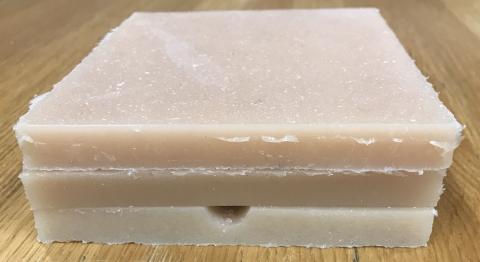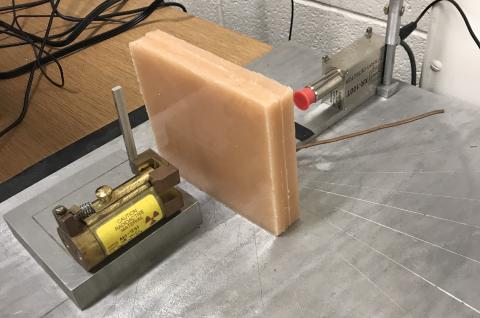Five slabs, each 1.5 cm thick, were manufactured. They were made of PMC 121/30 Dry mixed with 2.8% calcium carbonate. This material created a flexible rubber slab, one of which had a channel cut into it to fit a dosimeter. After researching the various dosimeters commonly used in medical phantoms, a MOSFET dosimeter was chosen, due to its ability to get immediate feedback without a need for further processing. Using the five slabs, breast thicknesses of 3, 4.5, 6, and 7.5 cm could be tested. To test the density of the slabs, small pieces of PMC were weighed and then their volume was found. The slabs were then taken to the NEEP lab at RPI, and using the Am-241 source (which has an energy peak at 59.5 keV, close to a mammogram's 25 keV) and CdTe detector, the attenuation of each slab thickness was found and then graphically analyzed, to find the mass attenuation coefficient of the material. The goal was to use the Cs-137 source in the RadEng lab at RPI to test the phantom with the MOSFETs, but the power supply for the dosimeters could not be found and the test could not be performed. Instead, MCNP was used to compare the measured dose between modeled breast tissue and the PMC slabs.
Team: Abigail Agosto, Jennifer Collins, Matthew Padron
Project Motivation
Current breast phantoms on the market are directed towards testing the image quality of mammograms. If trends are to follow with mammograms as they did with CT scans, however, medical physicists will begin to instead shift their interest to accurately quantifying the dose received during a routine mammogram. In order to build a foundation for future research into breast phantoms that focus on dose, an understanding of how dose changes with breast size is needed. The purpose of this project is to design a breast phantom that has variable sizes and can be used to find how dose varies with breast thickness, as well as to test a new material for future phantom use.

Three PMC slabs stacked together, showing a breast size of 4.5 cm.
Project Description
Five slabs, each 1.5 cm thick, were manufactured. They were made of PMC 121/30 Dry mixed with 2.8% calcium carbonate. This material created a flexible rubber slab, one of which had a channel cut into it to fit a dosimeter. After researching the various dosimeters commonly used in medical phantoms, a MOSFET dosimeter was chosen, due to its ability to get immediate feedback without a need for further processing. Using the five slabs, breast thicknesses of 3, 4.5, 6, and 7.5 cm could be tested. To test the density of the slabs, small pieces of PMC were weighed and then their volume was found. The slabs were then taken to the NEEP lab at RPI, and using the Am-241 source (which has an energy peak at 59.5 keV, close to a mammogram's 25 keV) and CdTe detector, the attenuation of each slab thickness was found and then graphically analyzed, to find the mass attenuation coefficient of the material. The goal was to use the Cs-137 source in the RadEng lab at RPI to test the phantom with the MOSFETs, but the power supply for the dosimeters could not be found and the test could not be performed. Instead, MCNP was used to compare the measured dose between modeled breast tissue and the PMC slabs.

Two slabs set between an Am-241 source and a CdTe detector, to collect data to calculate the linear attenuation coefficient of the slabs
Results and Accomplishments
Density tests found that the density of the PMC was 1.020 plus/minus 0.01 g/cm3, compared with breast tissue which is 1.040 g/cm3. At an energy range of 60 keV, the mass attenuation coefficient of the slabs were measured to be 0.21 plus/minus 0.02 cm2/g, compared to breast tissue's 0.2006 cm2/g. This test result helps to support using PMC in future breast phantoms, due to its ability to attenuate low-energy photons similarly (within one uncertainty) to breast tissue. While the applicable-ness of MOSFETs could not be tested, due to the geometry of the phantom, a MOSFET dosimeter could be easily replaced by a TLD or an OSL dosimeter in a real application of the phantom.